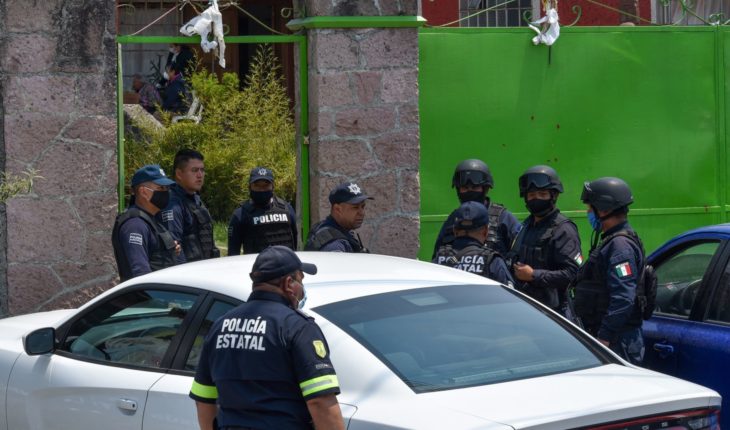From an armed confrontation inside a bar that left seven dead; going through an attack with high-power weapons and grenades on a local who cost four people their lives; even police killings, the undercharged murders of a powerful cartel, and thousands of people in alleged quarrels, attempted robberies, among others.
The coronavirus pandemic has not curbed violence in Mexico. On the contrary: in March and April this year – the first two months of the health emergency – 6,98 people were killed, 338 more people than in the same period last year. In 18 of the 32 states, the murders rebounded with everything and confinement.
Guanajuato is the entity with the most murders, but there are 30 cities throughout the country that alone concentrate 1 in 3 of the homicides and femicides recorded during the health emergency. In 17 of these cities, there are up to 100 percent increases in violence.
Phase 1 of the COVID-19 health emergency was decreed in Mexico on 28 February last after the first confirmed case was recorded. Phase 2 and the tightening of confinement for the spread of contagion were announced on 24 March and phase 3 in which we continued was ordered on 21 April.
Reads: Mexico exceeds 6,000 deaths per COVID-19, according to Health record
This led to a marked decrease in mobility, suspension of classes and non-essential activities, and the closure of most establishments.
This situation caused reports of most crimes to suffer an unprecedented reduction in April, reaching the lowest levels in 16 years. Yet murderous violence has not lost ground.
Official data from the National Public Security System show that in March and April 6,98 people were killed, among victims of wilful and femicide killings. These are 338 more victims compared to the same months last year, when the sum was 5,760 murders. It’s a 6% increase in total casualties.
The uptick in homicidal violence began since the early 2020s, but pandemic confinement has not stopped it. In January the daily average of murders was 93.3 victims; in February it amounted to 98.5; in March reached 99.3 victims every 24 hours; and in April the sweep of the five cases a day was overstepted to be in 100.6 murders.
The floodlights of violence
In the first two months of the coronavirus pandemic, homicides in Mexico grew in 18 states, or in the middle of the country, compared to the same period last year.
The largest upticks are recorded in Campeche where homicide victims grew 100%; in Michoacán where the ascent was 83.5%; Zacatecas with 46%; Hidalgo with a homicide growth of 37%; and Durango with a 30.8% advance.
It is followed in Chihuahua increments with a 23.3% advance; Nuevo León with a growth of 23.1%; Baja California with a 21.1% advance; Guanajuato with an increase of 20.1%.
Growth in Guanajuato, Chihuahua and Baja California is particularly worrisome as they are among the four entities with the most murders recorded during the pandemic period. They would be joined by the State of Mexico, where there was also a slight uptick in homicides of 2.8%.
The rest of the entities where there was a growth in homicidal violence are: Sonora, Yucatan, San Luis Potosí, Guerrero, Querétaro, Oaxaca, Colima and Morelos
The pockets of violence in the country become even clearer if the analysis is done at the municipality level.
There are 30 cities that alone accumulated 1,992 homicides in March and April, which equates to nearly one-third of all murders recorded in Mexico in the first two months pandemic. In 17 of these cities, doublose homicides grew compared to last year.
Of these there are five where more than one hundred percent went up. This is Ensenada, Baja California with a 195% shot in intentional homicides in full months of pandemic; Uruapan in Michoacán with an 182.4% advance; Cajeme in Sonora with a growth of 146.4%; Celaya, Guanajuato with a 136.7% advance; and Morelia, Michoacán with a 109% advance.
On the other hand, the three cities that recorded the most murders in the country are Tijuana in Baja California, Ciudad Juárez in Chihuahua, and León, Guanajuato, with 310, 299 and 94 intentional homicides, respectively.
The list of 30 cities is completed by Guadalajara, San Pedro Tlaquepaque, Tlajomulco de Zúñiga, Zapopan and Tonalá in Jalisco; Iztapalapa and Gustavo A. Madero in Mexico City; the municipalities of Solidaridad and Benito Juárez in Quintana Roo; cities d(e) Salamanca e Irapuato in Guanajuato.
Also the municipalities of Ecatepec and Nezahualcóyotl in the State of Mexico; Reynosa, Tamaulipas; Acapulco, Guerrero; Culiacan, Sinaloa; the capital of Chihuahua; Manzanillo, Colima; Hermosillo in Sonora; Monterrey, Nuevo León; Villahermosa, Tabasco, and the capital of Puebla.
Find out: After confinement, allegations of crimes in April fall to the lowest level in 16 years
The cases and their reasons
In the sum of the homicides recorded during the period of health emergency, several multihomicides stand out. Among them, for example, the one recorded on March 28 in Tultitlan, State of Mexico, inside a bar that contradicted the health recommendations was open.
According to local authorities, what happened was an apparent confrontation between armed people that left seven men dead and at least six others injured.
Another similar case where a grenade was even detonated occurred on March 24 at a bar in Celaya, Guanajuato that left a balance of four dead, In that same city, the multi-hospitalide of four people was recorded inside a house in the colony Hacienda Natura, on April 30.
Similar cases are counted by dozens. There was even only one afternoon, the one on March 31, where nine people were killed in Celaya and Valle de Santiago in Guanajuato, including a policeman.
In fact, in March and April at least 96 police officers were killed in different states of the country according to a report by the organization Cause in Common.
Add to these high-impact cases multiple homicides more recorded in clashes, revenge, alleged quarrels, attempted robberies, among others. More than 70% of them committed with firearms.
And while they do not yet enter this statistic, violence has continued at similar levels in May, even though the coronavirus pandemic is still being held. It is this last month, for example, the homicide of eight people on a road in Guanajuato on May 19; or the murder of Rodrigo Aréchiga alias “El Chino Antrax” alleged head of hitmen of the Sinaloa Cartel, which occurred last week in Culiacán.
Why does all this violence continue despite pandemic and confinement? Why doesn’t it at least decrease?
The expert on public and national security issues, Alejandro Hope, believes that there may be several reasons, but among the main ones is that much of the violence is linked to organized crime, a crime activity that moves apart from any citizen demobilization.
It should be noted that according to official estimates, at least 6 out of 10 murders would be related to organized crime, but there are states like Guanajuato or Jalisco where that percentage is greater than 80%.
“And it also happens that there are homicides that happen in houses, or that are products of more domestic violence, and those are not reduced with confinement but on the contrary,” the expert adds.
What we do in Animal Político requires professional journalists, teamwork, dialogue with readers and something very important: independence. You can help us keep going. Be part of the team.
Subscribe to Animal Político, receive benefits and support free journalism #YoSoyAnimal.
translated from Spanish: homicides go up in 18 states
May 21, 2020 |





